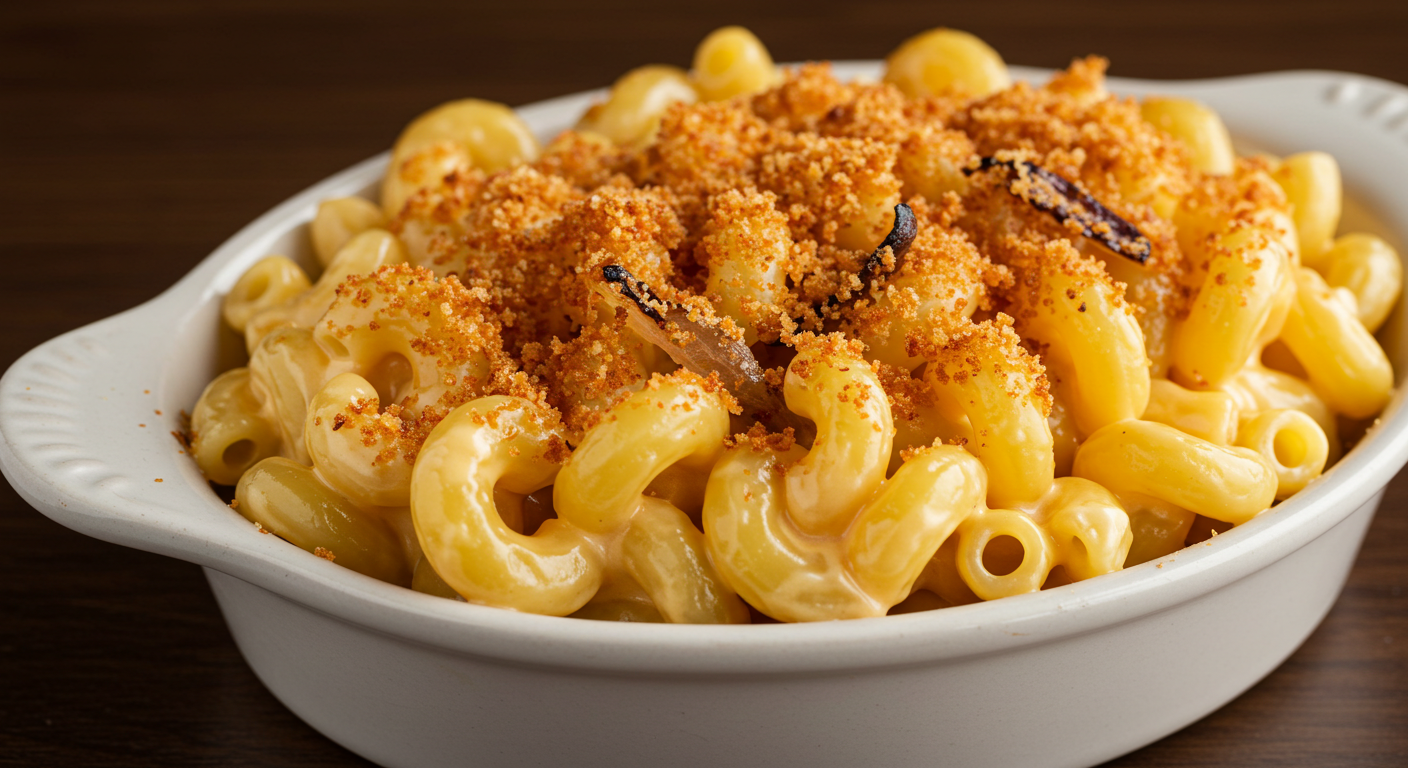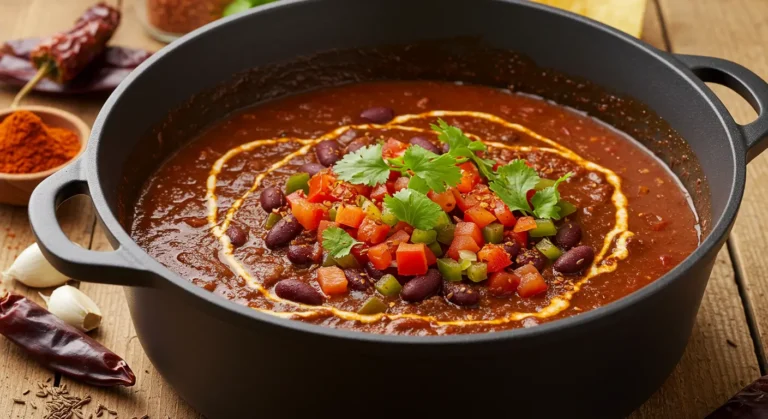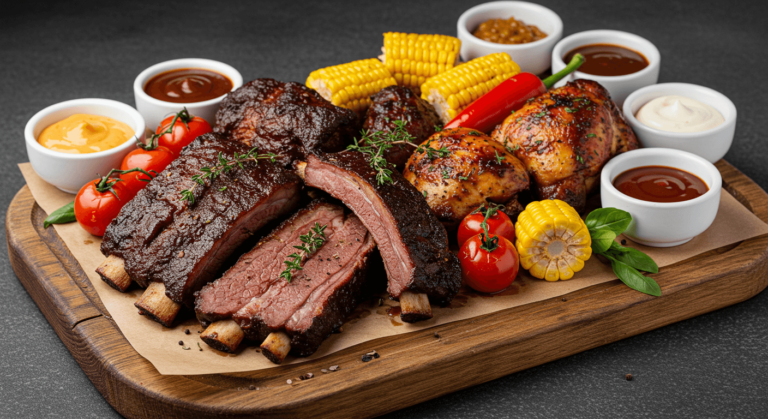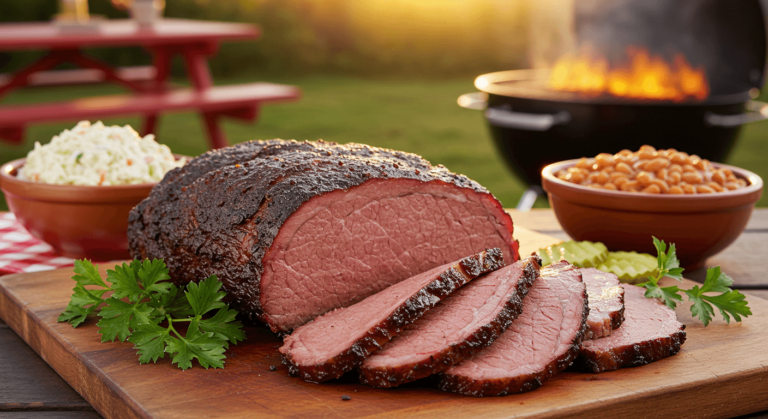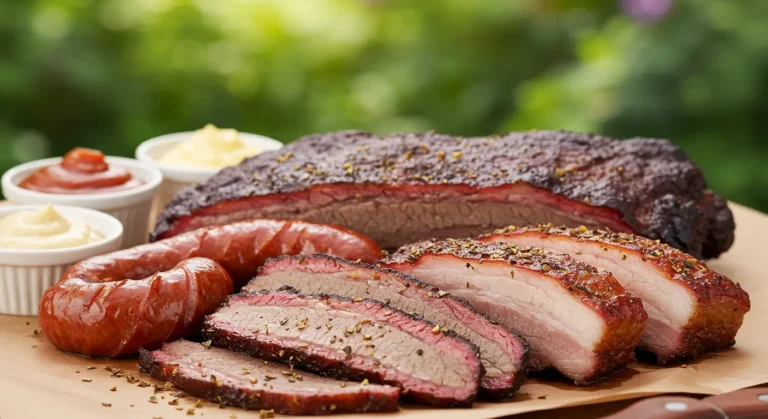Easy Smoked Mac and Cheese Recipe with Meat: The Ultimate Comfort Food Upgrade
smoked mac and cheese recipe
There’s something almost magical about the moment when smoke meets cheese—that perfect marriage of creamy, molten goodness with the subtle kiss of hardwood smoke. If you’ve never experienced smoked mac and cheese, particularly with the addition of perfectly smoked meat, you’re about to discover a whole new dimension of comfort food that will forever change your Sunday cookouts and family gatherings.
As someone who’s been smoking meats and perfecting recipes for over two decades, I can tell you that few dishes impress guests quite like a bubbling cast iron skillet of smoked mac and cheese pulled fresh from the smoker. The crispy top, the velvety interior, and those threads of smoke-infused flavor that weave through every bite make this dish nothing short of extraordinary.
In this comprehensive guide, we’ll walk through everything you need to know to create the ultimate smoked mac and cheese with meat. From selecting the right woods to choosing complementary meats and crafting the perfect cheese sauce, I’ll share the techniques and tips that have made this dish a signature at countless backyard gatherings and family celebrations.
What Makes Smoked Mac and Cheese So Special?
Before we dive into the recipe itself, let’s talk about why smoking transforms ordinary mac and cheese into something truly special. Unlike oven-baked versions, smoked mac and cheese develops complex flavor layers that simply can’t be replicated any other way.
“Smoke is like nature’s seasoning,” says championship pitmaster Chris Lilly. “It doesn’t just sit on top of the food—it penetrates and transforms it from the inside out.”
When you smoke mac and cheese, several things happen simultaneously:
- The cheese develops a deeper, more nuanced flavor profile
- The pasta absorbs smoky notes while maintaining its texture
- Any added meats continue to render and flavor the entire dish
- The top forms a perfect crust while the interior stays creamy
- The entire dish benefits from the low-and-slow cooking method
This is comfort food elevated to an art form—familiar enough to satisfy nostalgic cravings but sophisticated enough to impress even the most discerning BBQ enthusiasts.
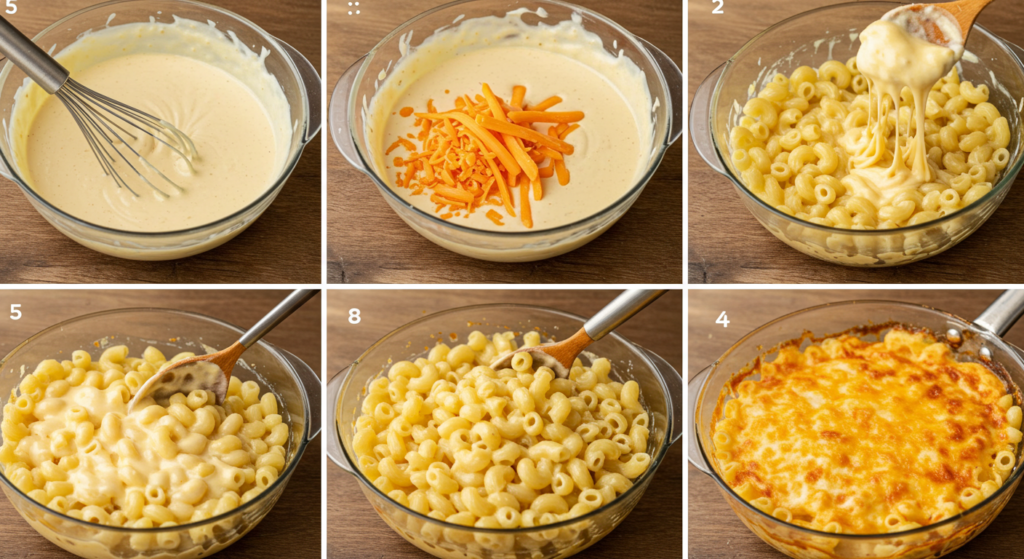
What Wood Should I Use for Smoking Mac and Cheese?
The choice of wood significantly impacts the final flavor of your smoked mac and cheese. Since pasta and cheese provide such a wonderful blank canvas, you can really get creative here.
For beginners, I recommend these woods for mac and cheese:
- Apple wood: Offers a mild, slightly sweet smoke that complements creamy dishes without overpowering
- Cherry wood: Provides a light, fruity smoke with a touch of sweetness
- Maple wood: Creates a subtle, sweet smoke that pairs beautifully with cheese
- Pecan wood: Delivers a rich, nutty smoke that enhances the cheese’s natural flavors
Woods to use more sparingly or mixed with milder varieties:
- Hickory: Has a stronger, bacon-like smoke that can be wonderful but potentially dominating
- Oak: Offers a medium smoke intensity that works well in combination with fruitwoods
Woods to avoid for this particular dish:
- Mesquite: Generally too intense and can overwhelm the delicate cheese flavors
Pro tip: For an interesting twist, try using a 70/30 mix of apple and hickory wood for a balanced smoke profile that complements both the cheese and any added meats.
How to Choose the Best Cheeses for Smoking
When it comes to creating the perfect smoked mac and cheese, cheese selection matters tremendously. You’ll want to balance melting qualities with flavor intensity.
Here’s my recommended cheese combination for the ultimate smoked mac and cheese:
- Sharp cheddar (8 oz): Provides the classic mac and cheese flavor and excellent melting
- Smoked gouda (6 oz): Enhances the smoky flavor and adds incredible creaminess
- Gruyère (4 oz): Offers nutty depth and superior melting properties
- Cream cheese (4 oz): Creates silky texture and binds the sauce beautifully
The key is balancing these cheeses to create depth while maintaining that perfect creamy consistency. Feel free to adjust based on your preferences, but always include at least one excellent melting cheese in the mix.
What Meat Goes Best with Smoked Mac and Cheese?
While smoked mac and cheese is delicious on its own, adding meat elevates it to a complete meal. The best meats for this dish are those that have been previously smoked and can be folded into the mac and cheese before the final smoking process.
Excellent meat options include:
- Smoked brisket: Chopped pieces add incredible richness and smoky depth
- Smoked chicken: Pulled or diced smoked chicken offers lighter flavor that doesn’t overwhelm
- Smoked turkey: Similar to chicken but with a slightly different flavor profile
- Bacon: Crispy, smoky bacon bits provide texture contrast and concentrated flavor
For an extra-special version, try using multiple meats—perhaps a combination of chopped brisket with crumbled bacon on top for texture variation.

What Equipment Do I Need for Smoked Mac and Cheese?
The beauty of smoked mac and cheese is that it doesn’t require specialized equipment beyond a smoker. Here’s what you’ll need:
- Smoker: Any type works—pellet, offset, electric, or even a kettle grill with indirect heat
- Cast iron skillet: 12-inch size is ideal (provides perfect crust-to-creamy ratio)
- Instant-read thermometer: For monitoring temperatures
- Heavy-bottomed pot: For preparing the cheese sauce
- Wooden spoon: For stirring (metal can sometimes cause cheese to break)
If you don’t have a cast iron skillet, an aluminum disposable pan will work, though you won’t get quite the same crust development on the bottom and edges.
How Long Does It Take to Smoke Mac and Cheese?
One of the best things about smoked mac and cheese is that it doesn’t require the extended cooking times of larger cuts of meat. Here’s a typical timeline:
- Preparation: 20-25 minutes
- Making the cheese sauce: 15-20 minutes
- Smoking time: 60-90 minutes at 225-250°F
- Resting: 10 minutes before serving
The total process takes about 2 hours from start to finish, making it manageable for even weeknight dinners if your smoker is already fired up.
What Are Common Mistakes When Smoking Mac and Cheese?
Before we dive into the recipe, let’s address some common pitfalls to avoid:
- Overcooking the pasta: Start with very al dente pasta as it will continue cooking in the smoker
- Using pre-shredded cheese: These contain anti-caking agents that prevent smooth melting
- Smoking at too high temperatures: This can break your cheese sauce and dry out the dish
- Under-seasoning: Mac and cheese needs proper seasoning to shine—don’t be shy with salt
- Uncovered smoking: Always leave your mac and cheese uncovered for maximum smoke exposure
Now that we’ve covered the fundamentals, let’s get to the main event—the ultimate smoked mac and cheese recipe with meat!
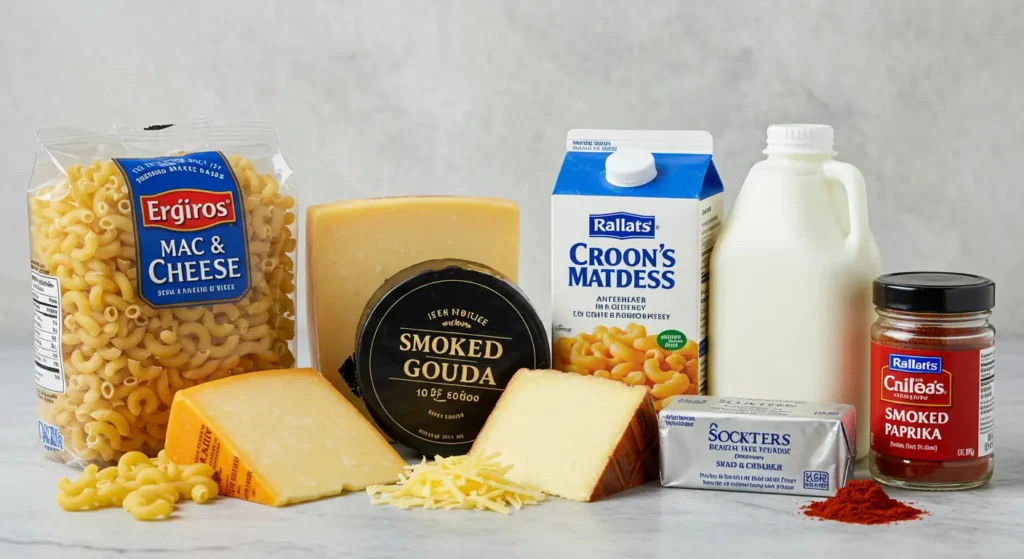
Easy Smoked Mac and Cheese Recipe with Meat
Ingredients
For the pasta:
- 1 pound (16 oz) elbow macaroni or cavatappi pasta
- 1 tablespoon kosher salt (for pasta water)
For the cheese sauce:
- 8 tablespoons (1 stick) unsalted butter
- ⅓ cup all-purpose flour
- 4 cups whole milk, warmed
- 2 teaspoons Dijon mustard
- 1 teaspoon garlic powder
- 1 teaspoon onion powder
- ½ teaspoon smoked paprika
- ¼ teaspoon cayenne pepper (optional)
- 1 teaspoon kosher salt
- ½ teaspoon freshly ground black pepper
- 8 oz sharp cheddar cheese, freshly grated
- 6 oz smoked gouda, freshly grated
- 4 oz gruyère cheese, freshly grated
- 4 oz cream cheese, softened and cubed
For the meat and topping:
- 2 cups chopped smoked meat (brisket, chicken, or turkey)
- 8 oz sharp cheddar cheese, freshly grated (for topping)
- ½ cup panko breadcrumbs
- 2 tablespoons melted butter
- 1 tablespoon fresh thyme leaves
- ¼ cup chopped green onions (for garnish)
Instructions
Preparation Phase
- Preheat your smoker to 225°F using your choice of wood (apple or cherry recommended for beginners).
- Bring a large pot of water to a boil. Add 1 tablespoon of kosher salt.
- Cook the pasta for 2 minutes less than the package directions indicate for al dente. The pasta should be quite firm as it will continue cooking in the smoker.
- Drain the pasta thoroughly and toss with a small amount of olive oil to prevent sticking. Set aside.
Creating the Perfect Cheese Sauce
- In a large, heavy-bottomed pot, melt the butter over medium heat.
- Add the flour and whisk continuously for about 1-2 minutes to create a roux, being careful not to let it brown.
- Gradually pour in the warmed milk while whisking constantly to prevent lumps.
- Continue cooking the sauce, stirring frequently, until it thickens enough to coat the back of a spoon (about 5-7 minutes).
- Reduce heat to low and add the Dijon mustard, garlic powder, onion powder, smoked paprika, cayenne (if using), salt, and black pepper.
- Remove the pot from heat and gradually add the cheddar, smoked gouda, and gruyère, stirring between additions until fully melted.
- Add the cream cheese cubes and stir until completely incorporated and the sauce is smooth.
Combining and Preparing for the Smoker
- In a large mixing bowl, combine the cooked pasta with the cheese sauce, folding gently until the pasta is completely coated.
- Fold in 1½ cups of your chosen smoked meat, reserving ½ cup for topping.
- Transfer the mixture to a well-seasoned 12-inch cast iron skillet.
- Sprinkle the remaining grated cheddar evenly across the top.
- Scatter the remaining ½ cup of meat across the cheese layer.
For the Crunchy Topping
- In a small bowl, mix the panko breadcrumbs with 2 tablespoons of melted butter and fresh thyme leaves.
- Sprinkle this mixture evenly over the mac and cheese.
Smoking Process
- Place the skillet in your preheated smoker.
- Smoke uncovered at 225°F for 60-90 minutes, or until the edges are bubbling and the top has developed a golden-brown crust.
- The internal temperature should reach approximately 165°F for perfect creaminess.
- Remove from the smoker and let rest for 10 minutes before serving.
- Garnish with chopped green onions just before serving.
What Can Go Wrong and How to Fix It
Even experienced pitmasters occasionally encounter issues. Here are some troubleshooting tips:
Too Dry
- Problem: Mac and cheese seems dry after smoking
- Solution: Keep some extra warm milk on hand. After smoking, you can gently fold in ¼ to ½ cup of warm milk to restore creaminess
Broken Sauce
- Problem: Cheese sauce appears curdled or separated
- Solution: This usually happens from too much heat. In the future, keep your smoker temperature steady at 225°F. For immediate fix, try stirring in 1-2 tablespoons of warm milk or cream off the heat
Not Enough Smoke Flavor
- Problem: The smoke flavor is too subtle
- Solution: Next time, smoke at a slightly lower temperature (200-225°F) for a longer period, or use slightly stronger wood like hickory mixed with fruitwood
Why This Recipe Works: The Science Behind Perfect Smoked Mac and Cheese
Understanding the science helps you perfect this dish every time:
- Starting with very al dente pasta: This prevents mushy texture as the pasta will continue absorbing liquid during smoking
- Making a proper roux: The equal parts fat and flour create the perfect suspension for cheese particles
- Gradual cheese addition off heat: This prevents the proteins in the cheese from seizing and creating a grainy texture
- Multiple types of cheese: Each contributes different properties—melting ability, flavor depth, and creaminess
- Uncovered smoking: Allows proper smoke circulation while the top develops a desirable crust
Variations to Try
Once you’ve mastered the basic recipe, consider these creative variations:
- Southwest Style: Add roasted green chilies, smoked chicken, and substitute pepper jack for some of the cheddar
- Buffalo Chicken: Mix in buffalo sauce with pulled smoked chicken and blue cheese crumbles
- Lobster Luxury: Add chunks of smoked lobster tail with a touch of Old Bay seasoning
- Italian-Inspired: Incorporate sun-dried tomatoes, smoked Italian sausage, and fontina cheese
Perfect Pairings
To complete your meal, consider these complementary sides:
- Crisp green salad with vinaigrette to cut through the richness
- Grilled asparagus or other green vegetables
- Crusty bread for sopping up any extra cheese sauce
- Pickled vegetables to provide acidic contrast
For beverages, amber ales, robust red wines, or even a smoky whiskey make excellent accompaniments to smoked mac and cheese.
Final Thoughts: Making Smoked Mac and Cheese Your Signature Dish
The beauty of smoked mac and cheese is that once you understand the fundamentals, you can adapt it endlessly to create your own signature version. Perhaps you’ll become known for your triple-meat mac and cheese with brisket, chicken, and bacon. Or maybe a four-cheese blend with a special spice mix will become your family’s most requested dish.
Remember that smoking is both an art and a science—embrace the variables, take notes on what works, and don’t be afraid to experiment. The perfect smoked mac and cheese is ultimately the one that makes your guests ask for seconds and your recipe.
So fire up that smoker, grate that cheese, and prepare to elevate a humble comfort food into something truly extraordinary. Your smoked mac and cheese journey is just beginning, and the delicious possibilities are endless.
FAQs About Smoked Mac and Cheese
Have You Tried This Recipes!
There are no reviews yet. Be the first one to write one.

